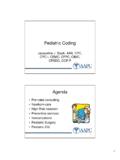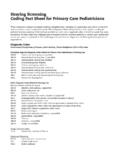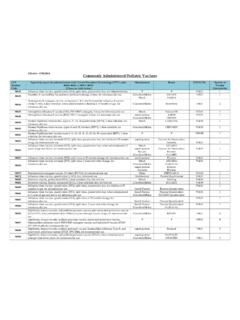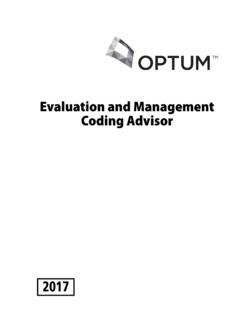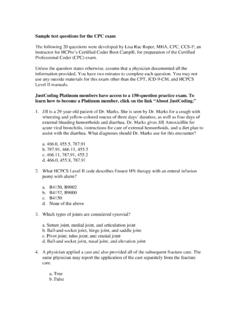Transcription of Pediatric Coding and Billing - Amazon Web Services
1 Pediatric Coding and BillingKim Huey, MJ, CHC, CPC, CCS-P, PCS, CPCOS andy Giangreco, RHIT, CCS, CCS-P, CHC, CPC, COC, CPC-I, COBGCE valuation and ManagementOfficeHospitalCounselingWell-c hild CareCommon Office ProceduresVaccinations and Other InjectionsUnderutilized Codes -per AAP2 Evaluation and Management ServicesSame Documentation Guidelines as for adultsLimitations? Review of Systems on small child? Social History School performance Extracurricular activities Marital status of parents/Living arrangements3 The Basics of E&M Documentation GuidelinesTwo sets of guidelines established by CMS 1995 Documentation Guidelines 1997 Documentation GuidelinesProviders may use whichever they are instructed to audit under both sets of guidelines and allow the physician to use whichever benefits Ancillary staff may document Review of Systems and Past, Family, Social History Provider must personally document History of Present Illness Chief complaint may be inferred.
2 May use patient-completed history form, but provider must date and initial form and refer to it in documentation. 5 Chief Complaint -History of Present Illness History of Present Illness expands on chief complaintLocation QualitySeverityDurationTiming ContextModifying factorsAssociated signs & symptoms6 History of Present IllnessIn lieu of HPI elements, can list the status of three chronic conditions CMS clarified that this can also be applied to the 1995 GuidelinesHow often will you use this in Pediatrics?7 Review of Systems The history element that is most often lacking May indicate All other systems negative after documentation of related system IF reviewed all But must list at least one system specifically ROS Negative is insufficient documentation for complete Review of Systems8 Review of Systems Constitutional Eyes Ears, Nose, Mouth, Throat Cardiovascular Respiratory Gastrointestinal Genitourinary Musculoskeletal Integumentary Neurological Psychiatric Endocrine Hematologic/Lymphatic Allergic/Immunologic9 Past, Family, Social HistoryPast current medications; hospitalizations; surgeries; vaccinationsFamily-hereditary diseases; health status of parents, siblings, childrenSocial smoking, alcohol and drug use; marital status; living arrangements; level of education.
3 Employment historyDifferent considerations for Pediatrics?10 Examination 1997 Guidelines Bullets 1995 Guidelines Body areas/Organ systems 8 organ systems required for comprehensive examination11 Medical Decision-MakingThis is the documentation of the physician s thought process Number of Diagnoses and Management Options Amount and Complexity of Data Risk12 Contributory Components Nature of Presenting Problem Time13 Nature of Presenting Problem How sick is this patient? Indicates medical necessity May be considered the tie-breaker when deciding between two levels of service. May not necessarily be reflected by the diagnosis of Presenting ProblemNature of Presenting ProblemLevel of ServiceOfficeInpatientSelf-limited or minor problem99201/99202/99212 Two or more self-limited or minor problemsOne stable chronic illnessAcute uncomplicated illness or injury99203/9921399221/99231 One or more chronic illnesses with mild exacerbation, progression, or side effects of treatmentTwo or more stable chronic illnessesUndiagnosed new problem with uncertain prognosisAcute illness with systemic symptomsAcute complicated injury99204/9921499222/99232 One or more chronic illnesses with severe exacerbation,progression.
4 Or side effects of treatmentAcute or chronic illness or injury that poses a threat tolife or bodily functionAbrupt change in neurologic status99205/9921599223/9923315 CounselingEvaluation and Management codes may be assigned based on time if counseling and coordination of care exceed 50% of the time CPT, time is spent with the patient and/or family so patient does not have to be present. (But be aware of any payer-specific requirements that the patient be present.) 16 Counseling Time Time must be documented as well as subjects discussedEx: I spent 20 minutes of this 25 minute visit discussing treatment options for the patient s new diagnosis of asthma. -99214Ex: I spent this entire 40-minute visit counseling with the parents regarding the patient s behavior problems at school and the possible diagnosis of ADHD.
5 -9921517 New Patient9920199202992039920499205(must meet all 3)Historychief complaint1-3 HPIchief complaint1-3 HPI1 ROSchief complaint4 or more HPI2 - 9 ROSpertinent PFSH chief complaint4 or more HPI10 or more ROScomplete PFSH chief complaint4 or more HPI10 or more ROScomplete PFSHE xamination1 system2 - 7 systems2 - 7 systems8 or more systems8 or more systemsMedicalDecision-Making(must meet 2 of 3)minimal diagnosesminimal/no dataminimal risk(must meet 2 of 3)minimal diagnosesminimal/no dataminimal risk(must meet 2 of 3)limited diagnoseslimited datalow risk(must meet 2 of 3)multiple diagnosesmoderate datamoderate risk(must meet 2 of 3)extensive diagnosesextensive datahigh riskTime(only relevant if counseling >= 50%)10 minutes20 minutes30 minutes45 minutes60 minutes18 Established Patient9921199212992139921499215(must meet 2 of 3)Historychief complaint1-3 HPIchief complaint1-3 HPI1 ROSchief complaint4 or more HPI2 - 9 ROSpertinent PFSH chief complaint4 or more HPI10 or more ROScomplete PFSHE xamination1 system2 - 7 systems2 - 7 systems8 or more systemsMedicalDecision-Making(must meet 2 of 3)minimal diagnosesminimal/no dataminimal risk(must meet 2 of 3)limited diagnoseslimited datalow risk(must meet 2 of 3)multiple diagnosesmoderate datamoderate risk(must meet 2 of 3)extensive diagnosesextensive datahigh riskTime(only relevant if counseling >= 50%)5 minutes10 minutes15 minutes25 minutes40 minutes1999213 or 99214?
6 Otherwise healthy child comes in with cough, congestion, pain in ears diagnosis is URI and otitismedia. Prescription is given for Amoxicillin. Documentation: Detailed history (4 HPI, 2+ systems reviewed, NKDA) Detailed examination (vitals, eyes, ENMT, heart , lungs) Moderate complexity (new problem, no addl workup, prescription drug management Nature of Presenting Problem: Acute, uncomplicated illness or injury2099213 or 99214? Child is seen one week later -presents with rash but no difficulty breathing or other systemic symptoms. Diagnosis is allergic reaction to Amoxicillin Detailed history Detailed examination Moderate complexity (New problem? illness with mild exacerbation, progression, or side effects of treatment) Nature of presenting problem ???2199213 or 99214? 14yopatient previously diagnosed with asthma presents with acute exacerbation Detailed history Detailed examination Complexity?)
7 Established problem worsening, prescription drug management What if diagnosis is URI in patient with asthma? Nature of presenting problem chronic illness with mild exacerbation supports 99214 Chronic illness with severe exacerbation -9921522 Office Visit with Procedures Modifier 25 -Significant, Separately Identifiable E&M Service by the Same Physician on the Same Day of Procedure or Other Service Beyond the usual preopand postopcare Different diagnosis is not required Be sure to check global periods on minor procedures23 Modifier 25 In general E&M Services on the same date of service as the minor surgical procedure are included in the payment for the procedure. The decision to perform a minor surgical procedure is included in the payment for the minor surgical procedure and should not be reported separately as an E&M service.
8 However, a significant and separately identifiable E&M service unrelated to the decision to perform the minor surgical procedure is separately reportable with modifier 25. The E&M service and minor surgical procedure do not require different diagnoses. If a minor surgical procedure is performed on a new patient, the same rules for reporting E&M Services apply. The fact that the patient is new to the provider is not sufficient alone to justify reporting an E&M service on the same date of service as a minor surgical procedure. NCCI contains many, but not all, possible edits based on these principles. NCCI ManualHospital CareUnless critical care for patients under the age of five, use the same codes and guidelines as for critical care Services under the age of five, the codes are per day and inpatient only Age 1-28 days 99468 initial/99469 subsAge 29 days 24 months 99471 initial /99472 subsAge 2 5 years 99475 initial/99476 subs25 Neonatal Intensive CareInitial Neonatal Intensive Care99477 initial hospital care, per day, for E&M of neonate, 28 days or less, who requires intensive observation, frequent interventions.
9 And other intensive care servicesProgression well-baby 99460sick baby 99221-99223intensive 99477critical 99295 26 Hospital Admission No office visit is to be charged on the date a patient is admitted to the hospital The CPT codes for hospital admission indicate Initial hospital care, per day all Services provided that day are rolled into that one code. What if patient is admitted from the office but not seen in the hospital on that day?27 Hospital AdmissionsBilled the date of visit Three levels 99221 99222 9922328 Subsequent Visits Three levels 99231 99232 99233 It is expected that the level of service will decrease during the hospital stay Diagnosis Coding code for what you saw the patient for that day! Issues with Concurrent Care29 Descriptions Important99231 Usually, the patient is stable, recovering or improving.
10 99232 ..the patient is responding inadequately to therapy or has developed a minor complication. 99233 Usually, the patient is unstable or has developed a significant complication or a significant new problem. 30 Initial Inpatient Care (Hospital Admit H&P)Subsequent Care (Daily Visits)9922199222992239923199232992333 of 33 of 33 of 32 of 32 of 32 of 3 Historychief complaint4 or more HPI2 -9 ROS1 element PFSH chief complaint4 or more HPI10 or more ROScomplete PFSH chief complaint4 or more HPI10 or more ROScomplete PFSH interval historychief complaint1-3 HPIinterval historychief complaint1-3 HPI1 ROSinterval historychief complaint4 or more HPI2 -9 ROSpertinent PFSHE xamination2 -7 systems/areas(in detail)8 or more systems8 or more systems1 system/area2 -7 systems/areas2 -7 systems/areas(in more detail)MedicalDecision-Making(must meet 2 of 3)minimal diagnosesminimal/no dataminimal risk(must meet 2 of 3)multiple diagnosesmoderate datamoderate risk(must meet 2 of 3)












